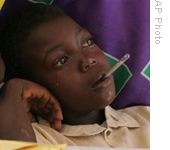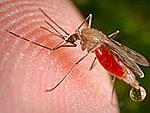VOA慢速英语-SCIENCE IN THE NEWS - Desire to End Malaria Makes Se
搜索关注在线英语听力室公众号:tingroom,领取免费英语资料大礼包。
(单词翻译)
Medical science has eliminated only one disease, smallpox1. Bill and Melinda Gates called last year for a campaign to stop malaria2. But experts differ on the idea. Some say existing measures could reduce cases by 90 percent. Transcript3 of radio broadcast:
30 June 2008
VOICE ONE:
This is SCIENCE IN THE NEWS in VOA Special English. I’m Bob Doughty4.
VOICE TWO:
And I’m Faith Lapidus. Today we tell about malaria. The disease threatens people in more than one hundred countries.
(MUSIC)
VOICE ONE:
 |
| A young malaria patient waits for treatment at a refugee camp in South Dafur, Sudan, last year |
The United States Centers for Disease Control says up to five hundred million people worldwide get malaria each year. The disease kills more than one million malaria patients every year. Many victims are young children in southern Africa.
Malaria also strikes parts of Asia, the Middle East, Central and South America, Hispaniola and islands of the Pacific Ocean.
Early identification and treatment can shorten the sickness and prevent damage to the body’s organs. But many countries that report malaria cases do not have enough money to support campaigns against the disease. And malaria itself resists attempts to defeat it.
VOICE TWO:
The Bill and Melinda Gates Foundation has given more than one billion dollars to fight malaria. Last year, Mister and Missus Gates said the international health community should attempt to permanently5 end the threat from the disease. The head of the World Health Organization supports the Gates’ goal. W.H.O. director general Doctor Margaret Chan has urged other experts to attempt to defeat the disease.
But only one communicable disease, smallpox, has ever completely disappeared. Some experts are not sure malaria should be attacked with the goal of destroying it. They say earlier such efforts led to unrealistic hopes, but then failed.
The head of the W.H.O.’s anti-malaria program says current methods could reduce malaria cases by ninety percent. Doctor Arata Kochi said this could happen if enough resources were available to fight the disease.
VOICE ONE:
 |
| Malaria is spread by the Anopheles mosquito |
A common insect, the mosquito, spreads malaria. Thecarries the parasite6 that causes the disease. Very small parasites7 develop in the stomach of the mosquito. Parasites are organisms that live on or in another animal and get their food from that animal.
The general name for the malaria parasite is Plasmodium. Mosquitoes pass the parasites to people when they drink blood through the skin. However, only the female Anopheles mosquitoes drink blood. The males feed only on liquids from plants.
The female Anopheles mosquito drinks blood from people and animals by breaking through the skin with its long, tube-like feeding device. The parasites enter the blood of the victim.
VOICE TWO:
The blood carries the parasites to the victim's liver. From there they invade cells and reproduce. After nine to sixteen days, the parasites return to the blood and enter the red blood cells. Then they reproduce again. As they do this, they destroy the blood cells. In a short time, the victim develops a high body temperature. The victim becomes weak and is unable to carry out normal activities.
Other signs of malaria include pain in the muscles or head and shaking. Patients with severe malaria may develop liver and kidney failure, seizures8 and become unable to communicate.
(MUSIC)
VOICE ONE:
Signs of malaria have been observed since the beginning of history. Scientists examining bodies of ancient Egyptians have found evidence of the disease in people who lived at least three thousand years ago. And scientists have found hardened remains9 of mosquitoes millions of years old.
At one time, it was believed that bad air caused malaria. People believed this bad air came from areas of water that were not deep and did not move. It seemed that malaria was most common near these swamps.
Ancient people suspected that mosquitoes were linked to malaria. The Greek historian Herodotus lived about two thousand four hundred years ago. He noted10 that in swampy11 areas of Egypt, some people slept in tall structures where mosquitoes could not go. Or they slept under nets that mosquitoes could not go through.
VOICE TWO:
In eighteen seventy-six, British scientist Patrick Manson discovered that mosquitoes were responsible for passing the disease to human beings. More exactly, he found that insects carry the parasites and pass them to humans.
In eighteen eighty, a French doctor, Alphonse Laveran, discovered that the Plasmodium parasite causes the disease. In eighteen ninety-seven, a British scientist, Ronald Ross, found the malaria parasite in the Anopheles mosquito.
For his discovery of the cause of malaria and other work, Doctor Laveran received the Nobel Prize for Medicine in nineteen-oh-seven. Five years earlier, Mister Ross received the Nobel Prize for Medicine for his work on malaria.
The discoveries of the three scientists soon led to efforts to control malaria. Then, the discovery of the insect poison D-D-T led to efforts to destroy the disease.
VOICE ONE:
Between nineteen fifty-five and nineteen sixty-nine, the World Health Organization organized campaigns against the disease. The goal was to use chemicals to kill mosquitoes in homes around the world.
The effort was successful in large areas of North America, southern Europe, the former Soviet12 Union and some parts of Asia and South America. The spread of the disease in these areas was halted.
However, the disease remained in Central America, parts of South America, and some Asian countries. A W.H.O. campaign never was attempted in Africa. It was too difficult and costly13 for most African countries.
VOICE TWO:
In nineteen sixty-eight, malaria suddenly spread in Sri Lanka, where it was believed the disease no longer existed. At the time, the island nation was known as Ceylon. Malaria also spread in Central America, in Southeast Asian nations, and in parts of Africa.
Efforts to destroy the disease throughout the world were suspended in nineteen sixty-nine.
(MUSIC)
VOICE ONE:
There are four different kinds of malaria. They are caused by four different kinds of parasites. Three of them cause victims to suffer high body temperatures every few days. But they do not cause death. However, the most common malaria parasite also is the most dangerous. This parasite causes infections that can lead to death.
The best way to prevent malaria is to stay away from the mosquitoes that carry the malaria parasites. The female Anopheles mosquito takes blood from its victims mainly at night.
So, people can place material specially14 treated with insect poison over their beds while they sleep. People can also put anti-insect chemicals on their skin, on clothing and in sleeping areas. They can wear clothes that cover most of the body.
VOICE TWO:
If the mosquitoes get past barriers used to block them, early drug treatment is needed to be effective. Drugs can destroy the malaria parasite as soon as it enters the human body. This prevents the parasites from entering the red blood cells and dividing. Some drugs can prevent the parasite from establishing itself in the liver.
A recent study found that a protein could provide a way to block the parasite’s actions in the mosquito. The protein would act before the mosquito can infect a human victim. The Global Health Infectious Diseases Research Team at the University of Florida carried out the study.
VOICE ONE:
Before the fifteenth century, people in what is now Peru knew the covering or bark from the cinchona tree was effective in treating signs of malaria. In eighteen-twenty, two French scientists identified the substance in the bark as quinine. Until the twentieth century, quinine was the chief drug used to prevent and cure some forms of malaria. Today, manufactured drugs treat the disease. The World Health Organization says combination treatments are best for common malaria.
VOICE TWO:
A new drug meant for common malaria is now being launched in Latin America and Southeast Asia. The medicine, known as ASMQ, combines two existing drugs.
The Brazilian government and a not-for-profit organization are making the new drug available to public agencies. Bernard Pecoul heads the organization, The Drugs for Neglected Diseases Initiative. He says ASMQ reduces the number of pills the patient needs to remember to swallow. Doctor Pecoul says the treatment is safe, fast-acting and effective for children and adults.
(MUSIC)
VOICE ONE:
This SCIENCE IN THE NEWS program was written by Jerilyn Watson. Our producer was Brianna Blake. I’m Bob Doughty.
VOICE TWO:
And I’m Faith Lapidus. Read and listen to our programs at voaspecialenglish.com. Join us at this time next week for more news about science on the Voice of America.
 收听单词发音
收听单词发音 




